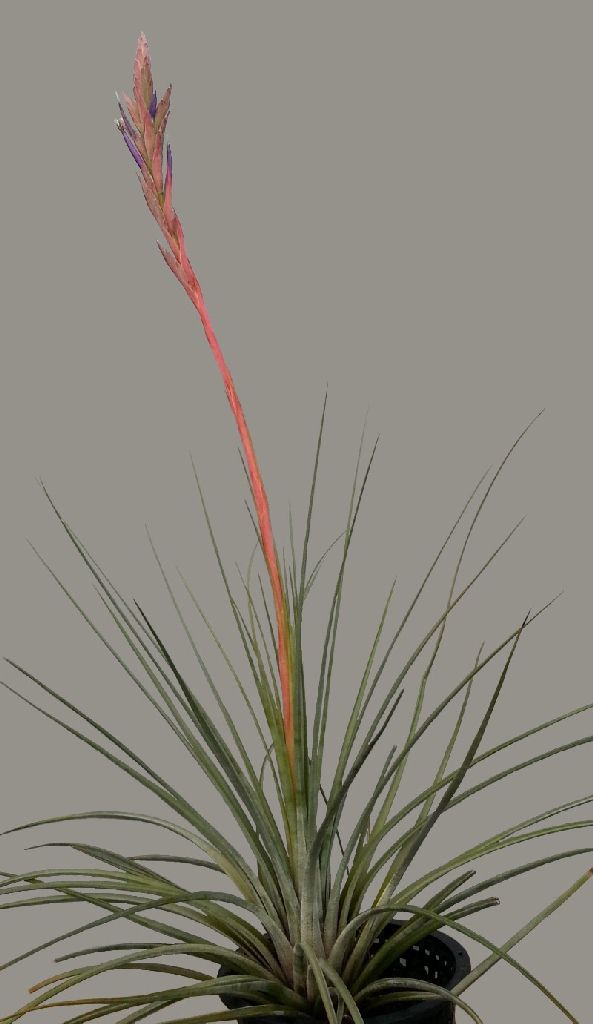
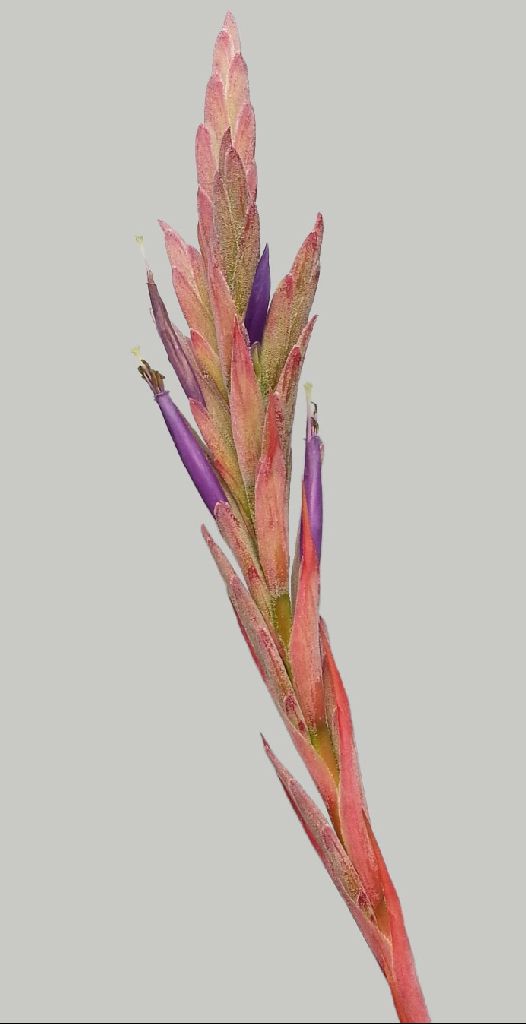
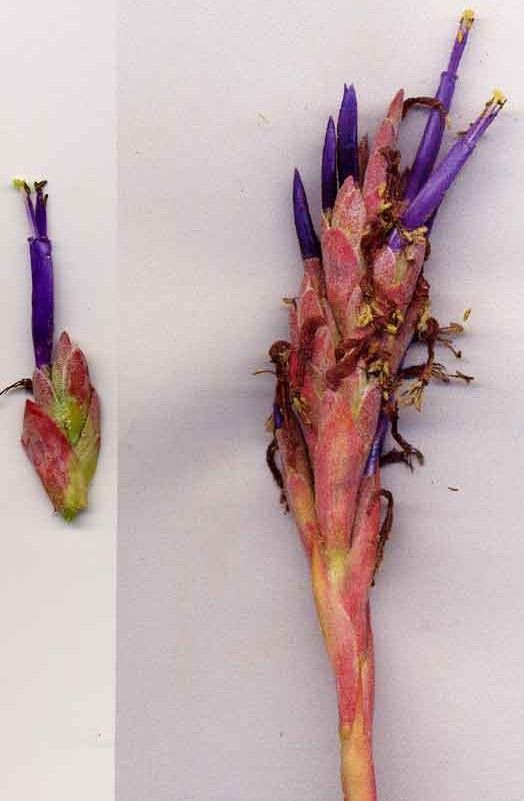
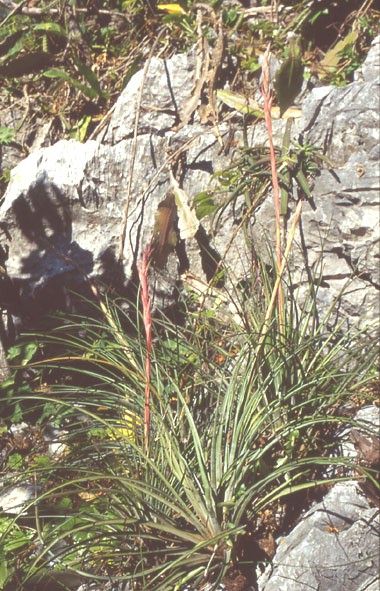
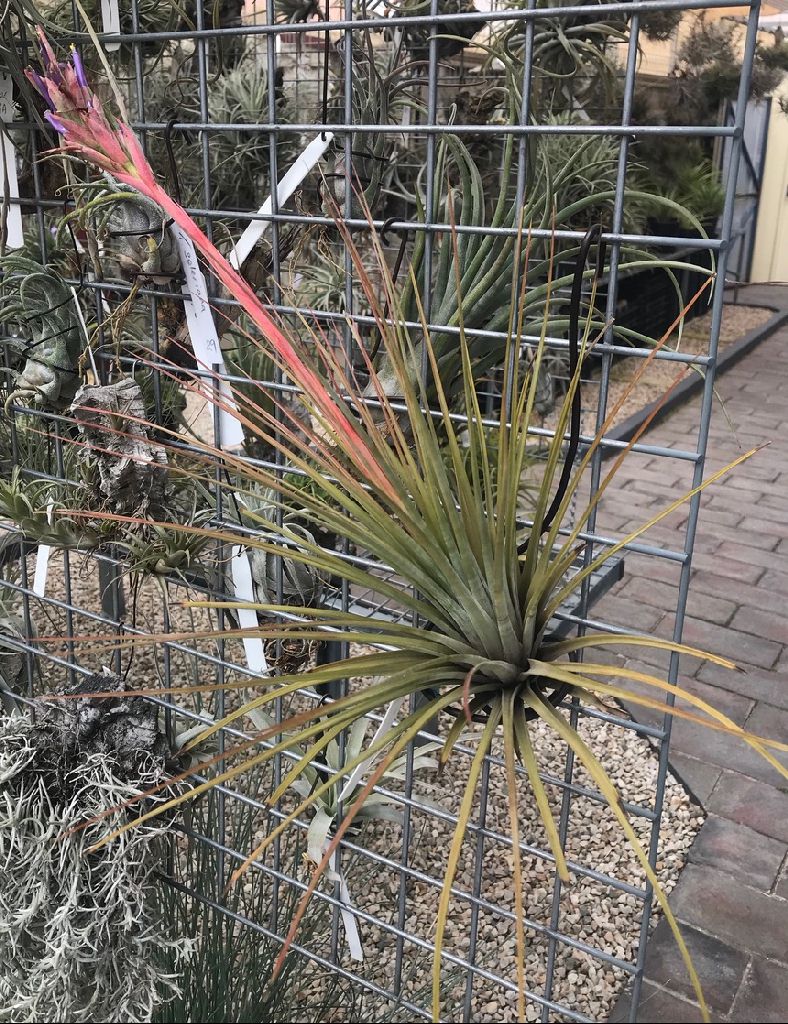
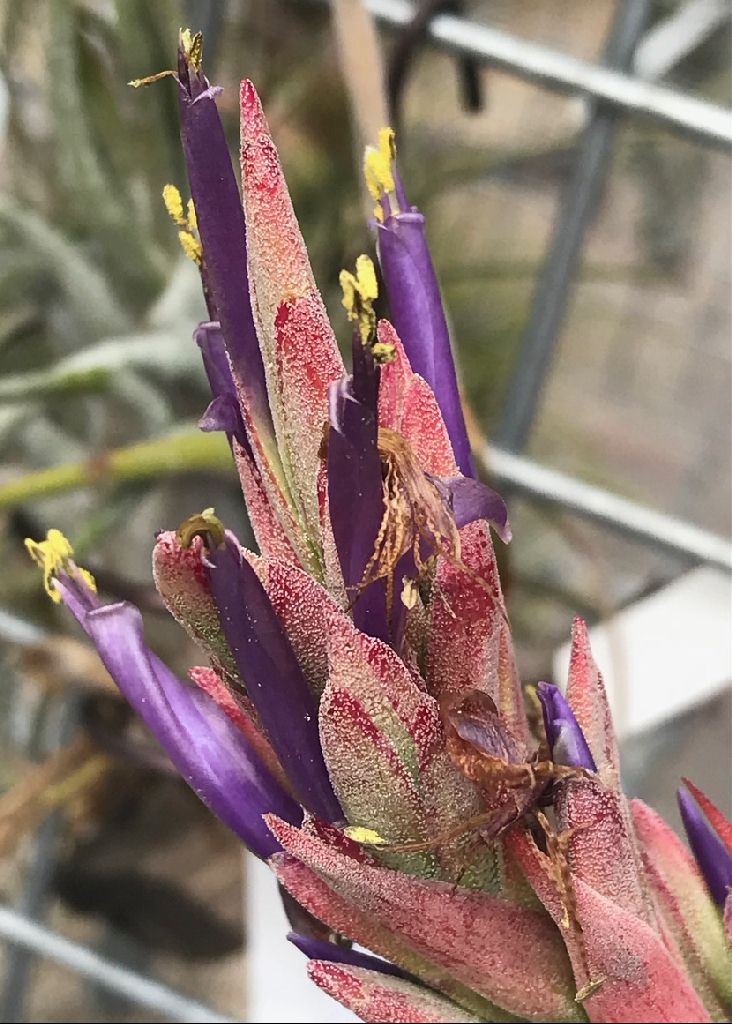
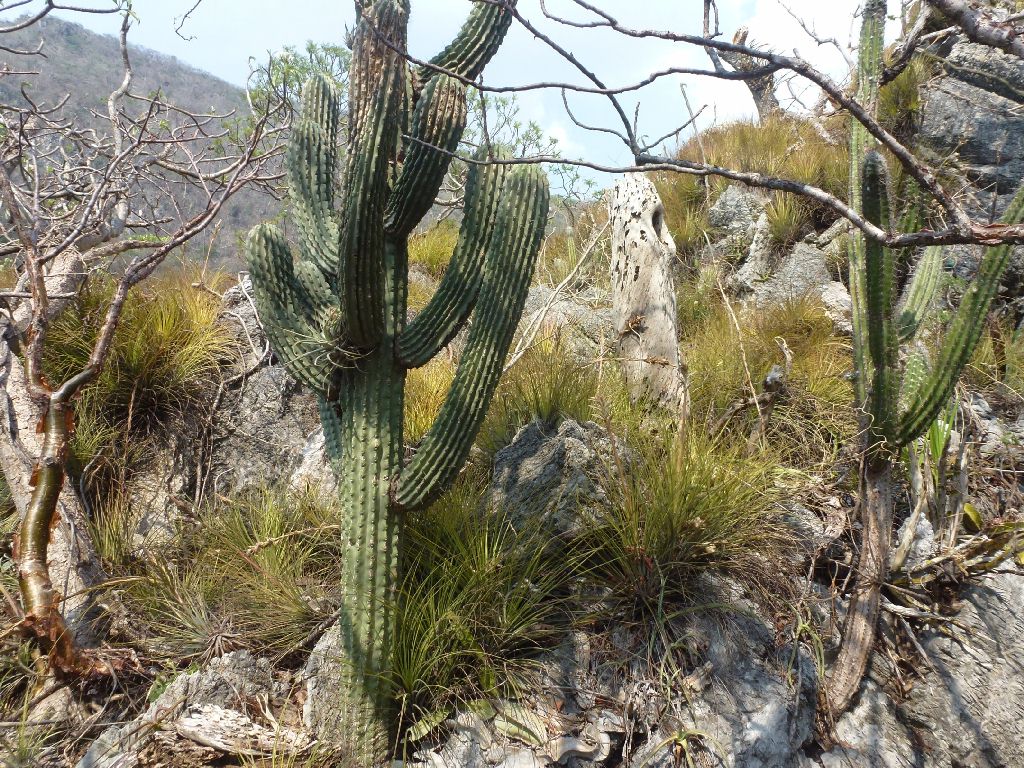
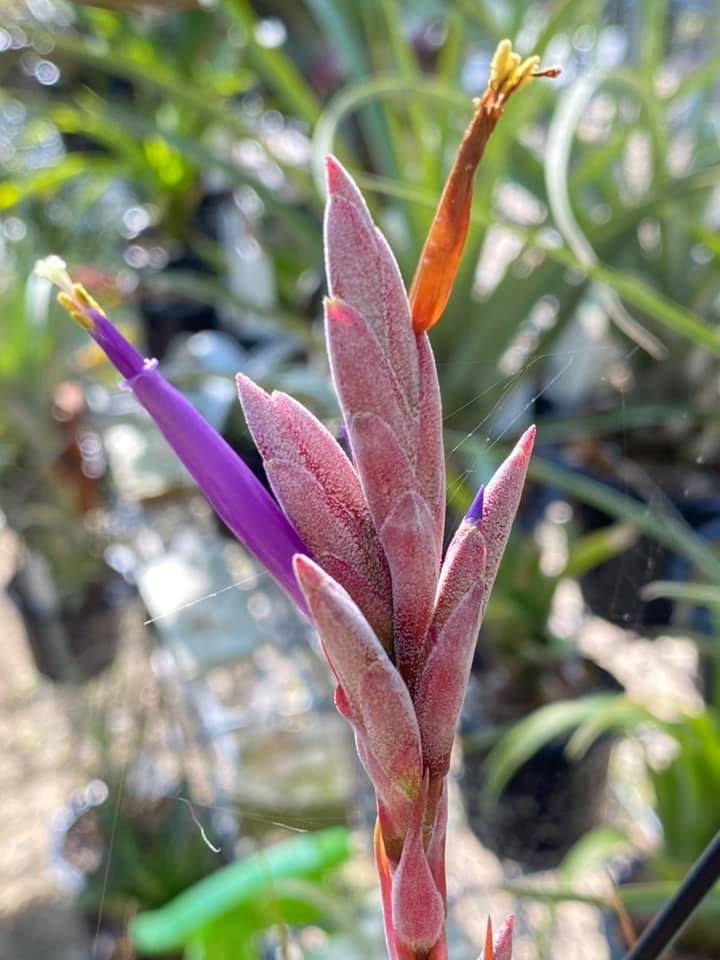
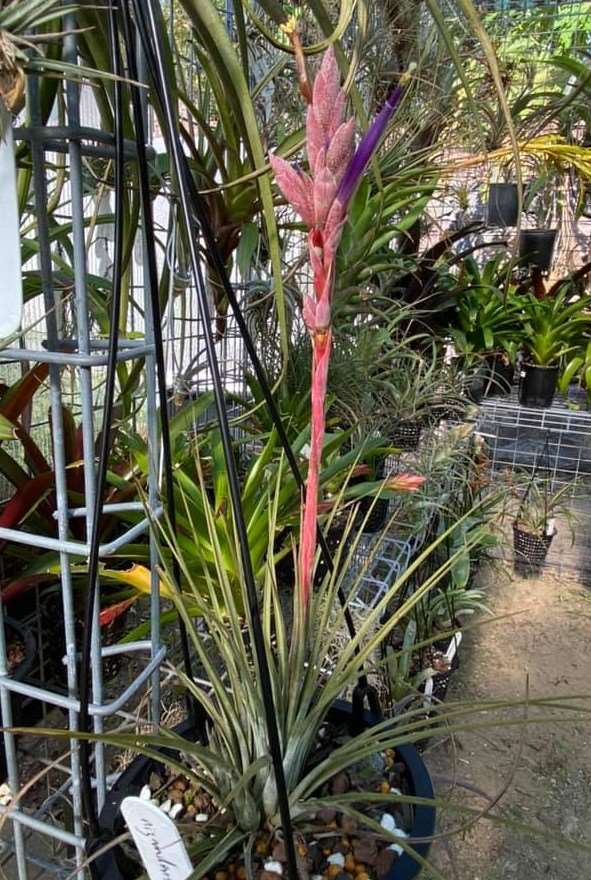
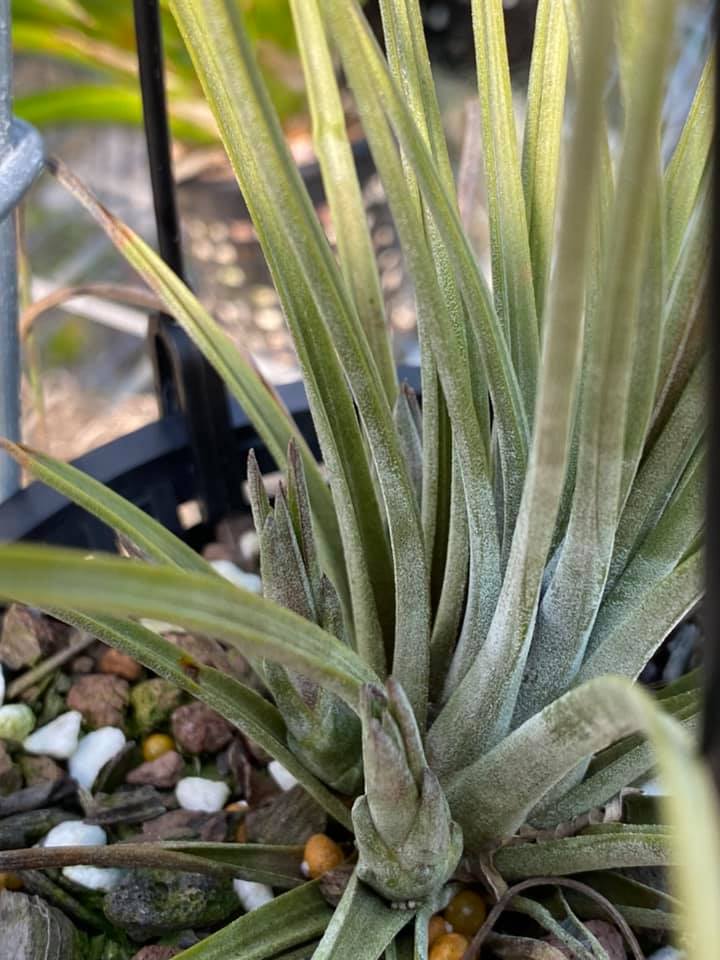
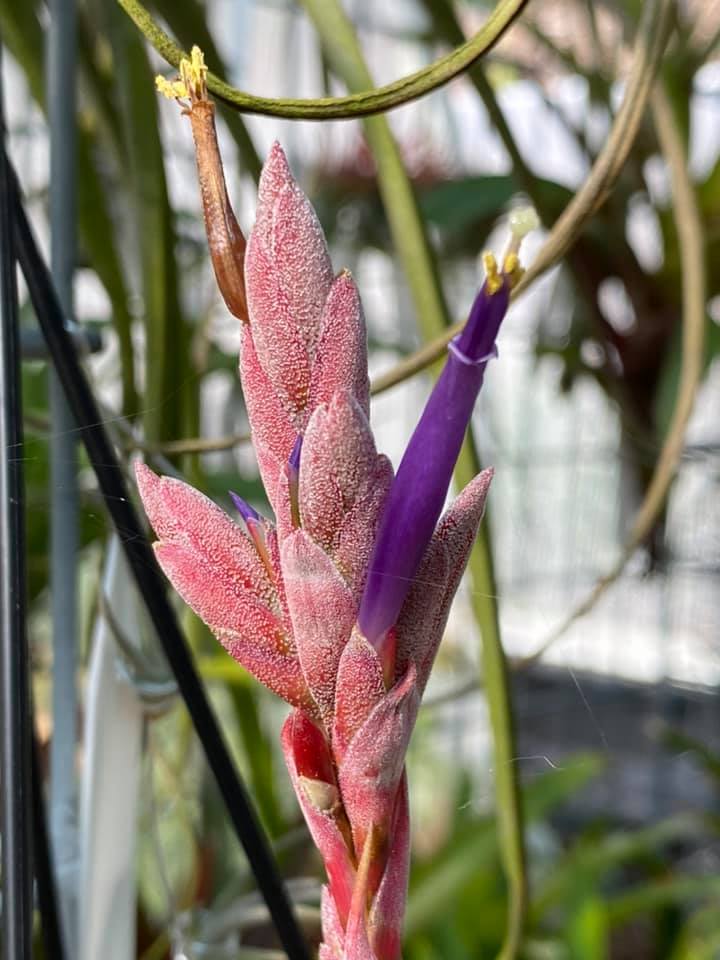
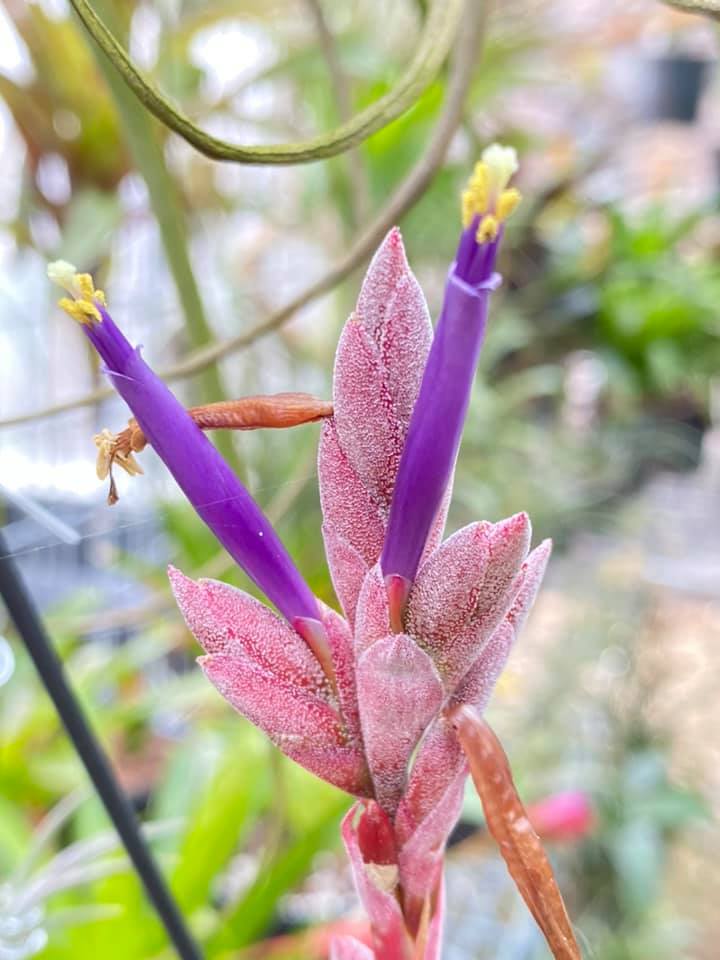
Plant growing on rocks and forming large groups, pups connected to the mother plant by 5-15 cm long, strong, brown stolons, flowering 60-120 cm high, forming an upright, but frequently spreading rosette, 30-60 cm high, 25-45 cm in diameter.
Leaves numerous, coriaceous, nearly succulent, at the base tightly fascicled and only 5-10 mm wide. The basal leaves strongly reduced and without leaf-blade.
Sheaths distinct, along the axis erect and densely appressed to each other, 2.5-3.5 cm long, at the base 2-2.5 cm wide, nearly triangular, brown, on both sides densely brown lepidote.
Leaf blades above the sheaths 8-12 mm wide, up to 40 cm long, narrowly triangular, leaf margins nearly parallel, adaxial side canaliculate, coriaceous, dark green, on both sides densely coloured by appressed greyish white scaly trichomes, therefore appearing greyish green, distal half of the blade recurved, forming a spreading rosette, blade tapering to a long apex, acute.
Peduncle erect, 30-60 cm long. exceeding the leaf rosette, round, 5-7 mm in diameter, densely imbricate and covered by the erect, foliose bracts, axis hidden from the sight, internodes nearly as long as the carmine red sheaths, basal ones bearing up to 15 cm long grey blades, apical ones reduced and mediating to the primary bracts.
Inflorescence (fertile part) distinctly exceeding the rosette, 10-20 cm long, 2.5-4 cm wide, cylindric, panicle with side branches of 1st order, frequently up to 2nd order (once- to twice-branched), axis straight, round in diameter, lateral branches 8-15, erect or spreading, spirally arranged around the axis, internodes (0.5-)1-1.5 cm.
Primary bracts carmine red, the sheaths of the lower mostly half of the length of the spikes, blades mostly as long as the spikes or somewhat longer, narrowly acuminate, the blades of the primary bracts of the apical spikes somewhat shorter and just acute, covering the wide side of the spike or the lateral branches.
Spikes mostly simple or together with one to two smaller and narrower lateral spikes forming a lateral branch; main spikes (3-) 4-6 cm long, 8-15 mm wide, stipitate, stipe ca. 5 mm long, spike lanceolate or elliptic, complanate, distichous, composed of 3-6 floriferous and, located at the base, up to 3 flowerless bracts, rhachis angular, green and lepidote, hidden from sight; length of the lateral spikes ca. half to two thirds of the main spikes, appressed to the narrow side of the main spike, floral bracts and sepals of the lateral spike smaller than those of the main spike.
Floral bracts (1-) 1.8-2.3 cm long, exceeding the sepals, (7-)9-11 mm wide, narrowly elliptic, apex nearly obtuse, distinctly carinate, at base frequently double-carinate, coriaceous, adaxial side glabrous, nerved, abaxial side red, densely covered with spreading, fine silvery trichomes.
Sepals (12-)16-19 mm long, (3-)4-4.5 mm wide, narrowly elliptic, barely acute, thin coriaceous, the abaxial ones conspicuously carinate and basal half to two thirds connate, light green, sparsely, but distinctly covered with small scales.
Petals 3.4-4.2 cm long, 6 mm wide, tapering to the base to 3 mm wide, ligulate, forming an erect tube with tightly closed throat, the apices only very slightly recurved, bright violet, towards base white.
Stamens 7-10 mm exceeding the flower; filaments 3.3-4.1 cm long, in two whorls of different length, straight, violet, towards base white, in apical part 0.75 mm wide, in cross section oval, towards base narrowing strap-shaped, anthers 2-2.5 mm long, 0.8 mm wide, elliptic, erect, at one third from the base versatile, yellowish brown, pollen lemon yellow.
Style 3.5- 4.4 cm long, white, stigma erect, 2 mm long, 1.5 mm wide, (only slightly wider than the style), greenish, slightly papillose, Typ I according to Brown & Gilmartin (1984).
Ovary 4 mm long, 2 mm wide at the base, conical, somewhat triangular, light green.
Habitat and distribution - T. nizandaensis comes from Mexico. It was found in Nizanda in the state of Oaxaca, and is known so far only from this locality.
Etymology - This new species is named after the area where it was found, Nizanda in Oaxaca, Mexico.
Discussion
This plant seems to belong to the relationship of T. hammeri Rauh & Ehlers. It differs from T. hammeri in the following characteristics (compare Rauh & Gross 1987):
Plants larger and forming a spreading, not narrowly erect rosette, the pups are attached to the mother plant by long stolons, leaves greener, inflorescence branching frequently up to 2nd degree, more compact, internodes between the spikes shorter, spikes much wider, floral bracts exceeding the sepals and longer (up to 2.3 cm instead of 1.5 cm), strongly and clearly visible carinate, sepals slightly lepidote and more connate.
A new species from Oaxaca, Mexico : Tillandsia nizandaensis by Renate Ehlers.
In 1995, a new Tillandsia was discovered when Lydia and Gerhard Kohres from Erzhausen were searching for Agave nizandensis in Oaxaca, close to Nizanda. After returning to Germany they recognised their find as very unusual and revisited the site and collected new plant material in December 1996. Aside from that, this new species was collected and photographed at its natural habitat by Gerd Ehlinger and Jutta Pfeifer from Konigstein in 1996.
In March 1998, I visited the place together with my friends Brunhilde, Jurgen and Uli Lautner. We found many of the new Tillandsia and were happy to see a lot of them in flower. The shrubs were full of a small form of T. ionantha, known to the enthusiasts as T. ionantha “Haselnuss", as well as T. concolor and T. fasciculata. Above that we saw beautiful red flowering Hechtia and many orchids. It was truly a botanical garden of paradise. Despite the strong warm coastal wind howling and blowing us off the rocks, we were in wonder and couldn't get enough from climbing and photographing.
In the following years I repeatedly had the opportunity to visit the habitat together with Lydia and Gerhard Kohres or Jurgen and Uli Lautner, Manfred Kretz and Gunther Noller. Alas, reports from there are not positive. The shrubby forest is cleared to the rocks and maize is growing instead. In the rocks, almost no tillandsias and orchids were found anymore. The hot wind was still blowing over the rocks - but where is the plant diversity gone!
Plants of that species grow and flower easily under cultivation conditions. After flowering, they produce a number of pups, which are connected to the mother plant by long stolons. Lydia Kohres found a very interesting hybrid between Tillandsia nizandaensis and T. ionantha and could propagate it successfully. ( See ‘Juchitan’ in the BCR)
Lydia and Gerhard Kohres report on the discovery of Tillandsia nizandaensis and Wolfgang Polka and his wife Johanna from Frankfurt report about the vegetation growing along with T. nizandaensis as follows.
By Lydia & Gerhard Kohres.
In my "agave period" we were in search of Agave nizandensis, which was still unknown to me at that time. The location is given as Nizanda, Tehuantepec. But Nizanda was not to be found on any map. In Tehuantepec I did not find anyone either who knew where that is. Finally, in Salina Cruz, we found a truck driver, who knew where it is. So we came via La Mata to the little village of Nizanda which lies on the plain at a railroad line. But the agave could not grow there. So we drove back and towards Tuxtepec, uphill the whole way. When Nizanda was well below us the first rocks and quarries came into view, where searching for said agave could pay off.
The rocks consist of washed out firm limestone, which somewhat further up, by Guiengola, is mined as marble. So I climbed up on these rocks and was surprised to find a number of plants which one seldom sees in one spot in such numbers at this low elevation. The location is only 200 meters above sea level and in December at 11 am the thermometer already showed 34°C. But the mountains are situated at the isthmus of Tehuantepec. That is the narrowest spot in Mexico and a strong wind from the Pacific is practically always blowing. That's the reason the largest wind farm in Mexico is located here. I found all sorts of things up here, just not the Agave nizandensis I was looking for. But I did find something unfamiliar which I thought was an aloe. It turned out later that this “aloe" was the agave I had been looking for! Among the plants to be encountered here are Hechtia rosea, Anthurium nizandensis, Opuntia sp., Pachycereus pecten-aboriginum, Penicereus nizandensis, Pilosocereus collinsii, Cephalocereus nizandensis, Selenicereus grandiflorus var. lautneri, Strophocactus testudo, Mammillaria collinsii, Epiphyllum hookeri, Nolina congesta, Peperomia pereskiifolia, Oncidium cebolleta, Schomburgkia sp., Barkeria whartoniana and an alba form as well as other orchids. The following tillandsias could be found: Tillandsia caput-medusae, T. concolor, T. fasciculata, T. ionantha “hazelnut”, T. makoyana, and a species unknown to me which will be described now as T. nizandaensis.
Interestingly, this one does not grow on other plants or on rock but sits loosely between the rocks. Jatropha “Mala mujer" is also abundant here. Whoever has come into contact with her will not forget it for the rest of his life. The location was severely damaged by a tornado, many Cereus were twisted off and knocked over. At our last visit in December 2015, however, everything had been regenerated and looked quite untouched.
By Johanna & Wolfgang Polka.
Mr. and Mrs. Kohres, my wife and I were travelling in Mexico. On November 18, 1992 we drove from Salinas Cruz toward Oaxaca. At km 229 shortly after passing a vulcanisadora (tire repair shop) a road led to a wooded mountain hill. The first thing we saw were some Jatropha urens plants, which warned us to be careful because touching the stinging hairs causes inflammation and swelling which doesn't go away for several days. After searching the very steep scarp, we found a path into the woods. There we discovered a very interesting plant community.
We saw many large specimens of Beaucarnea stricta (elephant's foot), which measured as much as a meter in diameter on the ground. We saw several columns of an Acanthocereus sp. Other cacti: Deamia testudo with its broad, flat shoots, and Selenicereus sp., both of them climbing up the trees. On the semi-shaded ground among round rocks overgrown with plants there was Agave nizandensis with its fragile leaf blades and Tillandsia nizandaensis, which, not in bloom, looked rather unimpressive. Also an Opuntia sp., Hechtia and Plumeria grandiflora were among the ground dwellers. As epiphytes we found T. ionantha with permanently rust-red leaf blades, T. concolor and among the orchids Oncidium luridum, Oncidium sp., Schomburgkia sp. and Barkeria scandens.
The temperature at 3:00 p.m. in sunny but windy weather was 24.2°C (75.6°F). The elevation was 100 m above sea level.